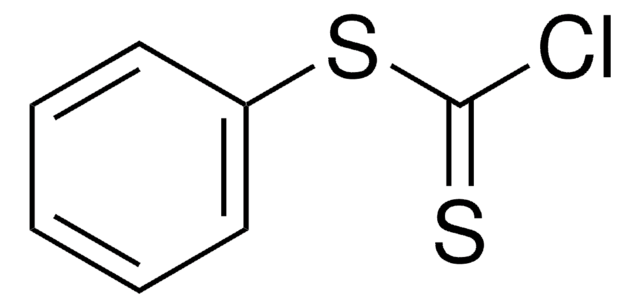234524
O-Phenyl chlorothionoformate
99%
Synonym(s):
Phenyl thionochloroformate
About This Item
Recommended Products
Assay
99%
form
liquid
refractive index
n20/D 1.581 (lit.)
bp
81-83 °C/6 mmHg (lit.)
density
1.248 g/mL at 25 °C (lit.)
SMILES string
ClC(=S)Oc1ccccc1
InChI
1S/C7H5ClOS/c8-7(10)9-6-4-2-1-3-5-6/h1-5H
InChI key
KOSYAAIZOGNATQ-UHFFFAOYSA-N
Looking for similar products? Visit Product Comparison Guide
Related Categories
Application
- stereodirected synthesis of optically active, (−)-mintlactone
- synthesis of peptide α-thioesters having a variety of C-terminal amino acids
- synthesis of scyllo-inositol derivatives
- thionocarbonylation of unprotected thymine nucleosides
- preparation of phenoxythiocarbonyl esters of protected ribonucleosides
Signal Word
Danger
Hazard Statements
Precautionary Statements
Hazard Classifications
Skin Corr. 1B
Storage Class Code
8A - Combustible corrosive hazardous materials
WGK
WGK 3
Flash Point(F)
177.8 °F - closed cup
Flash Point(C)
81 °C - closed cup
Personal Protective Equipment
Certificates of Analysis (COA)
Search for Certificates of Analysis (COA) by entering the products Lot/Batch Number. Lot and Batch Numbers can be found on a product’s label following the words ‘Lot’ or ‘Batch’.
Already Own This Product?
Find documentation for the products that you have recently purchased in the Document Library.
Our team of scientists has experience in all areas of research including Life Science, Material Science, Chemical Synthesis, Chromatography, Analytical and many others.
Contact Technical Service



![1-Chloromethyl-4-fluoro-1,4-diazoniabicyclo[2.2.2]octane bis(tetrafluoroborate) >95% in F+ active](/deepweb/assets/sigmaaldrich/product/structures/206/487/53d52ee5-ef71-4e9a-9bc8-938b68b98d5d/640/53d52ee5-ef71-4e9a-9bc8-938b68b98d5d.png)




